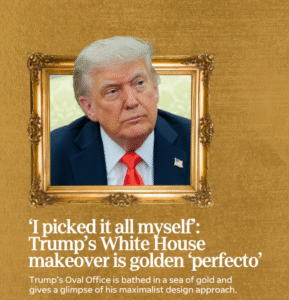Former President Donald Trump made no secret of his preference for bold, opulent design—and during his time in the White House, that aesthetic made its mark on the presidential residence in ways not seen in recent administrations. Known for his love of gold accents, classical grandeur, and showy luxury, Trump leaned heavily into a style reminiscent of European palaces and upscale hotels, and he claimed, “I picked it all myself,” when speaking of the décor choices.
While past presidents often deferred to official White House curators, historic preservation experts, or first ladies in decisions related to interior design, Trump took a more personal, hands-on approach. He reportedly involved himself directly in design decisions, including choices around furniture, drapery, carpets, and art placement. Some changes were subtle, while others dramatically departed from the traditional, restrained look of previous years.
In several interviews and media appearances, Trump emphasized that he wanted the White House to feel “majestic” and “worthy of the presidency.” He often compared the traditional style to something “old and tired,” expressing his desire to modernize certain elements with a sense of drama and strength. One of the most talked-about additions was the new look of the Oval Office, where gold drapes returned after being removed by President Obama, and deep-toned furniture gave the space a darker, more formal feel.
Throughout the residence and ceremonial rooms, Trump reportedly favored rich color palettes—deep reds, royal blues, and dark woods—with plenty of gilded accents. These choices echoed the aesthetic seen in Trump Tower and his private residences, reflecting a consistent taste that favors ornate over minimalist.
In the West Wing, Trump is said to have overseen updates that brought a more imposing visual presence to key meeting spaces. He preferred heavy, commanding furniture and sharp, polished lines. In the Roosevelt Room and Cabinet Room, some observers noted the shift toward a more corporate, boardroom-style ambiance.
The State Dining Room also received attention during Trump’s presidency. Though major architectural changes were avoided due to historic preservation rules, Trump’s team introduced new fabrics, lighting adjustments, and framed artwork more aligned with his personal taste. Some reports indicated he had a strong say in the selection of art displayed throughout public areas, favoring portraits and landscapes with bold impact.
His private residence on the second floor was kept largely out of public view, but those familiar with the space said it bore even more of Trump’s personal imprint. Decorative pillows, elaborate chandeliers, and custom upholstery matched his lifelong penchant for over-the-top glamour. In one interview, Trump suggested that the residence should feel “like a world-class suite,” not just a home.
Critics often viewed these changes as a break from tradition, arguing that the White House should represent the dignity of the office rather than the preferences of a single occupant. Supporters, however, praised the updates as a refreshing assertion of leadership style and individuality. “It looks strong now,” one insider said, echoing Trump’s messaging.
Melania Trump also played a role in shaping the visual tone, though her influence was often more restrained. Her redesign of the White House Rose Garden, for example, sparked widespread debate. While some appreciated the cleaner, more structured look, others mourned the removal of historic plantings and colorful blooms. Still, the overall aesthetic shift in the Trump White House was unmistakably guided by the president himself.
Trump’s design choices often sparked conversations not just about taste but about symbolism. For example, the heavy use of gold and classical architecture was interpreted by some as a nod to power and permanence. Others saw it as excessive or self-indulgent. In either case, the changes were a reflection of Trump’s broader branding philosophy: big, bold, and unmistakably personal.
Since leaving office, the long-term legacy of Trump’s aesthetic influence on the White House remains a subject of curiosity. Some elements, such as carpeting and drapery, were likely reverted by the next administration, while other changes may persist as part of the building’s evolving story. But there’s no question that Trump brought a distinctive flair to 1600 Pennsylvania Avenue—one that matched the image he cultivated throughout his business and political life.
Whether loved or loathed, Trump’s redesign efforts served as a visual extension of his presidency: unapologetically flashy, intentionally provocative, and unafraid to break with precedent. As he once said, “When people walk in, I want them to say, ‘Wow.’” And for better or worse, many did.


